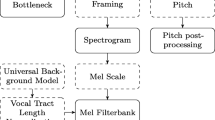Abstract
Some well known theoretical results concerning the universal approximation property of MLP neural networks with one hidden layer have shown that for any function f from [0,1]n to \(\mathcal{R}\), only the output layer weights depend on f. We use this result to propose a network architecture called the predictive Kohonen map allowing to design a new speech features extractor. We give experimental results of this approach on a phonemes recognition task.
An erratum to this chapter can be found at http://dx.doi.org/10.1007/11550907_163 .
Preview
Unable to display preview. Download preview PDF.
Similar content being viewed by others
References
Hermansky, H.: Should recogizers have ears? Speech Communication 25, 3–27 (1998)
Lapedes, A., Farber, R.: Nonlinear signal processing using neural networks: Prediction and system modelling. Internal Report, Los Alamos National Laboratory (1987)
Thyssen, J., Nielsen, H., Hansen, S.D.: Non-linear short-term prediction in speech coding. In: Proc. of Int. Conf. on Signal and Speech Processing, vol. 1, pp. 185–188 (1994)
Reichl, W., Harengel, S., Wolferstetter, F., Ruske, G.: Neural networks for nonlinear discriminant analysis in continuous speech recognition. In: Eurospeech, pp. 537–540 (1995)
Hunt, M.J., Lefebvre, C.: A comparison of several acoustic representations for speech recognition with degraded and undegraded speech. In: Int. Conf. on Speech and Signal Processing, vol. 2, pp. 262–265 (1989)
Biem, A., Katagiri, S.: Filter bank design based on Discriminative Feature Extraction. In: Proc. of Int. Conf. on Signal and Speech Processing, vol. 1, pp. 485–488 (1994)
Gas, B., Zarader, J.L., Chavy, C., Chetouani, M.: Discriminant neural predictive coding applied to phoneme recognition. Neurocomputing 56, 141–166 (2004)
Chetouani, M., Faundez-Zanuy, M., Gas, B., Zarader, J.L.: A New Nonlinear speaker parameterization algorithm for speaker identification. In: Proc. of ISCA Tutorial and Research Workshop on Speaker and Recognition Langage Workshop, pp. 309–314 (2004)
Hecht-Nielsen, R.: Kolmogorov’s mapping neural network existence theorem. In: Proc. of Int. Conf. on Neural Networks, pp. 11–13 (1987)
Girosi, F., Poggio, T.: Representation properties of networks: Kolmogorov’s theorem is irrelevant. Neural Computation 1(4), 465–469 (1989)
Hornik, K.: Multilayer feedforward networks are universal approximators. Neural Networks, 2, 359–366 (1089)
Author information
Authors and Affiliations
Editor information
Editors and Affiliations
Rights and permissions
Copyright information
© 2005 Springer-Verlag Berlin Heidelberg
About this paper
Cite this paper
Gas, B., Chetouani, M., Zarader, JL., Charbuillet, C. (2005). Predictive Kohonen Map for Speech Features Extraction. In: Duch, W., Kacprzyk, J., Oja, E., Zadrożny, S. (eds) Artificial Neural Networks: Formal Models and Their Applications – ICANN 2005. ICANN 2005. Lecture Notes in Computer Science, vol 3697. Springer, Berlin, Heidelberg. https://doi.org/10.1007/11550907_125
Download citation
DOI: https://doi.org/10.1007/11550907_125
Publisher Name: Springer, Berlin, Heidelberg
Print ISBN: 978-3-540-28755-1
Online ISBN: 978-3-540-28756-8
eBook Packages: Computer ScienceComputer Science (R0)




